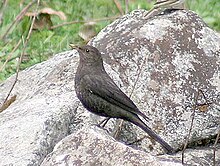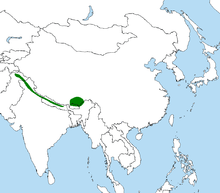The Tibetan blackbird (Turdus maximus) is a species of bird in the thrush family Turdidae. It is found in the Himalayas from northern Pakistan to southeastern Tibet. Originally described as a separate species by Henry Seebohm in 1881, it was then considered a subspecies of the common blackbird until 2008, when phylogenetic evidence revealed that it was only distantly related to the latter species. It is a relatively large thrush, having an overall length of 23–28 centimetres (9–10 inches). Males are blackish-brown all over with darker plumage on the head, breast, wings and tail and dull orange-yellow bills, while females have browner underparts, faint streaking on the throat, and a dull darkish yellow bill. Both sexes may seem slightly hooded. It can be differentiated from the common blackbird by its complete lack of an eye-ring and reduced song.
| Tibetan blackbird | |
|---|---|

| |
| A female | |

| |
| A male | |
| Scientific classification | |
| Domain: | Eukaryota |
| Kingdom: | Animalia |
| Phylum: | Chordata |
| Class: | Aves |
| Order: | Passeriformes |
| Family: | Turdidae |
| Genus: | Turdus |
| Species: | T. maximus
|
| Binomial name | |
| Turdus maximus (Seebohm, 1881)
| |

| |
| Synonyms[2] | |
| |
The Tibetan blackbird inhabits steep grassy, rocky slopes and alpine meadows above the tree line. Usually found at elevations of 3,200–4,800 metres (10,500–15,700 feet), it descends to lower elevations in the winter, but seldom below 3,000 m (9,800 ft). It is omnivorous, feeding on invertebrates, lizards, fruit, and seeds. Breeding occurs from May to July, peaking from June to early July. Cup nests are made out of mud, animal hair, and fine grass and contain clutches of 3–4 eggs. The International Union for Conservation of Nature lists the species as being of least concern due to its large range, along with a large and increasing population.
Taxonomy and systematics edit
The Tibetan blackbird was originally described as Merula maxima by Henry Seebohm in 1881 on the basis of a specimen collected by Thomas Jerdon in Gulmarg, Kashmir.[3][4] It was subsequently considered a subspecies of the common blackbird by Charles Richmond in 1896,[5] and was moved to Turdus with that species.[6] It was raised to species status again in 2008 on the basis of phylogenetic evidence.[7] The generic name Turdus is from the Latin turdus, meaning thrush, while the specific name maximus is from the Latin maximus, meaning greatest.[8] Tibetan blackbird is the official common name designated by the International Ornithologists' Union.[9] It is also called the Central Asian blackbird.[10]
The Tibetan blackbird is one of 65 species in the genus Turdus. It was previously treated as a subspecies of the common blackbird (Turdus merula). However, a 2008 phylogenetic study by Johan Nylander and colleagues showed the Tibetan blackbird to be only distantly related to the common blackbird, with the species instead being sister to the white-backed thrush.[7] Richard and Annie Meinertzhagen described a proposed subspecies buddae on the basis of the smaller bills of birds from Sikkim and Gyangtse in 1925,[4] but this character is not consistent throughout the population, and the species is consequently treated as being monotypic.[9][11]
Description edit
The Tibetan blackbird is a relatively large thrush, being 23–28 centimetres (9–10 inches) in length. Males are brownish-black all over and darker on the head, breast, wings and tail, with dull orange-yellow bills. Females have blackish-brown upperparts and browner underparts, with faint streaking on the throat and a dull darkish yellow bill. Both sexes may appear slightly hooded. Juveniles are like females, but have greyish-buff on the back to wing-coverts and rump, greyish-buff streaking on the throat, and greyish-buff barring on the belly to vent. It differs from the common blackbird in its complete lack of an eye-ring and reduced song.[11]
Vocalisations edit
The song of the Tibetan blackbird is repetitious series of rapid grating notes, unpleasant squeaks, drongo-like wheezes, and guttural caws, with sporadic piew-piew whistles, given from a ridge top, rock, or trees. Unlike the song of the common blackbird, it does not have warbles or trills. Calls include a low-pitched chut-ut-ut, a staccato chak-chak-chak-chak given in flight, and a rattling chow-jow-jow-jow given as an alarm call.[11][12]
Distribution and habitat edit
The Tibetan blackbird is found locally in the Himalayas of India, Pakistan, Nepal, Bhutan, and China. During the breeding season, it inhabits steep grassy, rocky slopes and alpine meadows just above the tree line at elevations of 3,200–4,800 m (10,500–15,700 ft). In the winter, it descends to lower elevations, but rarely goes below 3,000 m (9,800 ft).[11]
Behaviour and ecology edit
Diet edit
The Tibetan blackbird is omnivorous, feeding on earthworms, molluscs, insects, small lizards, fruit, and seeds. It forages on the ground, hopping over rocks and boulders, and favours soft bare ground at the edge of melting snow for foraging. In late summer, foraging occurs in flocks of up to ten individuals.[11]
Breeding edit
The Tibetan blackbird's breeding season lasts from May to July, with breeding peaking from June to early July. Breeding occurs in juniper or rhododendron bushes. It builds a bulky cup nest with mud, animal hair, and fine grass. Nests are built in roots on the ground, at the foot of a boulder, in low bushes, on cliff faces, or against rocky walls. Cotoneaster microphyllus is the favourite plant for building nests in China. Eggs are large and dull buff to grey with brown blotches, and are laid in clutches of three or four. The time taken to incubate the eggs is 12–13 days and the time it takes for nestlings to fledge is 16–18 days. Nestlings are fed small worms. A study in China found the success rate of nests to be 59%.[11][13]
Status edit
The Tibetan blackbird is listed as being of least concern by the International Union for Conservation of Nature (IUCN) on the IUCN Red List due to its very large range, large population, and a population that appears to be increasing.[1]
References edit
- ^ a b BirdLife International (2018). "Turdus maximus". IUCN Red List of Threatened Species. 2018: e.T103892028A132202298. doi:10.2305/IUCN.UK.2018-2.RLTS.T103892028A132202298.en. Retrieved 18 November 2021.
- ^ "Turdus maximus (Tibetan Blackbird)". Avibase. Retrieved 2022-01-13.
- ^ Seebohm, Henry (1881). Catalogue of the Passeriformes or Perching Birds in the British Museum. Vol. 5. London. p. 405.
{{cite book}}: CS1 maint: location missing publisher (link) - ^ a b British Ornithologists' Club (1925). Bulletin of the British Ornithologists' Club. Vol. 46. London: British Ornithologists' Club. p. 98.
- ^ Richmond, Charles W. (1895). "Catalogue of a collection of birds made by Doctor W. L. Abbott in Eastern Turkestan, the Thian-Shan Mountains, and Tagdumbash Pamir, Central Asia, with notes on some of the species". Proceedings of the United States National Museum. 18. Washington: Smithsonian Institution Press: 585–586.
- ^ Cottrell, G. William; Greenway, James C.; Mayr, Ernst; Paynter, Raymond A.; Peters, James Lee; Traylor, Melvin A.; University, Harvard (1964). Check-list of birds of the world. Vol. 10. Cambridge: Harvard University Press. p. 177.
- ^ a b Nylander, Johan A. A.; Olsson, Urban; Alström, Per; Sanmartín, Isabel (2008-04-01). Baker, Allan (ed.). "Accounting for Phylogenetic Uncertainty in Biogeography: A Bayesian Approach to Dispersal-Vicariance Analysis of the Thrushes (Aves: Turdus)". Systematic Biology. 57 (2): 257–268. doi:10.1080/10635150802044003. hdl:10261/166999. ISSN 1076-836X. PMID 18425716. S2CID 16575186.
- ^ Jobling, James A. (2010). Helm Dictionary of Scientific Bird Names. London: Christopher Helm. pp. 244, 393. ISBN 978-1-4081-3326-2.
- ^ a b "Thrushes". IOC World Bird List. Retrieved 2021-11-03.
- ^ "Turdus maximus (Tibetan Blackbird)". Avibase. Retrieved 2022-01-13.
- ^ a b c d e f Collar, Nigel (2020-03-04). Billerman, Shawn M.; Keeney, Brooke K.; Rodewald, Paul G.; Schulenberg, Thomas S. (eds.). "Tibetan Blackbird (Turdus maximus)". Birds of the World. Cornell Lab of Ornithology. doi:10.2173/bow.tibbla1.01. S2CID 216488352. Retrieved 2021-11-02.
- ^ Boesman, Peter (2016). "Notes on the vocalizations of Tibetan Blackbird (Turdus maximus)" (PDF). HBW Alive Ornithological Note (312). Lynx Edicions.
- ^ Lu, Xin (2005). "Reproductive ecology of blackbirds (Turdus merula maximus) in a high-altitude location, Tibet". Journal of Ornithology. 146 (1): 72–78. doi:10.1007/s10336-004-0058-1. ISSN 0021-8375. S2CID 23827289.
